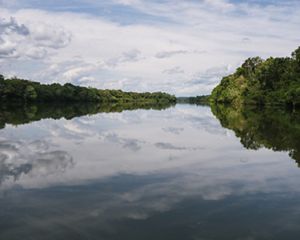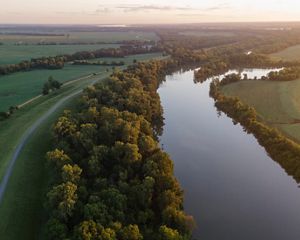
This article was written by Giulio Boccaletti, former Chief Strategy Officer & Global Ambassador for Water with The Nature Conservancy.
In 2009, I traveled deep into Southern Ethiopia, on the country’s arid border with Kenya. The area includes the Great Rift Valley, famous for its early human fossils, but I was there as a consultant looking for solutions to Ethiopia’s chronic water challenges. The region is so drought prone that the nomadic cattle herders who live there often have violent skirmishes over the control of watering holes for their livestock. Just to visit we needed a security detail armed with assault rifles.
This journey was a harsh reminder that no resource on Earth is as valuable as fresh water. Indeed, how a country manages its water can tell you a lot about the state of its economy and political stability. A study by Upmanu Lall and Casey Brown of Columbia University has shown that the prosperity of a country strongly correlates with how favorable its hydrology is. And a well-known World Bank model holds up Ethiopia as a stark example: The gross domestic product of the country—which is heavily dependent on rain-fed agriculture—grows in rainy years and falls substantially during years of drought.
What is true for Ethiopia holds for the rest of the world as well. No nation has managed to achieve prosperity without first delivering “water security”—without developing the infrastructure, institutions and practices needed to manage droughts and floods and to ensure a consistent water supply.

Today, however, water security, even in many rich countries, is in jeopardy. Our inability to adequately value water, to invest in the systems that allow us to carefully manage water, to allocate water to the most important uses (and avoid wasting it), and to protect the health of the watersheds from which we draw our water—all these failures threaten human health, prosperity and even political stability. These problems are widespread and getting worse. In fact, the World Economic Forum’s 2017 Global Risk Report ranked water crises above the threat of terror attacks and cyberattacks in terms of global impact. Over the past 10 years, water issues have been consistently listed by the organization as one of the top 10 threats to prosperity. Climate change is compounding that risk.
Yet I don’t believe that widespread water crises are a fate we are consigned to. I joined The Nature Conservancy because I have seen that combining sophisticated water management with investments in freshwater ecosystems can create the conditions for peace and prosperity.
An important part of achieving water security is restoring the ecological integrity of rivers, watersheds, wetlands, floodplains and aquifers, and treating these freshwater ecosystems as integral to the built infrastructure—reservoirs, water-treatment plants, etc.—we depend on for clean water. Embracing a blend of green and gray infrastructure and striking a healthy balance between nature and people are our best hope to overcome the chronic neglect of water resources.
As an organization, TNC has been field-testing strategies to protect and manage freshwater ecosystems for decades. That may sound surprising for an organization that got its start protecting land. But as one TNC scientist in Colorado puts it, “We realized pretty quickly that preserves that protect water supplies are worth a lot more, ecologically speaking.” The greatest threats to water systems across the world come from three difficult—but not unsolvable—problems: the enormous amount of water used by agriculture, poorly planned dams and other infrastructure on rivers, and the degradation of natural lands that supply water to our towns and cities.
Perhaps the most challenging threat is agriculture. Globally, about 70 percent of available fresh water is withdrawn for irrigation and other agricultural purposes. In places where water scarcity is a problem—about a third of the watersheds of the world—that percentage can grow to more than 90 percent. But there are ways to cut back water use without harming agricultural productivity, even in arid places.
Quote
Water security, even in many rich countries, is in jeopardy.
One simple institutional mechanism is the establishment of a well-regulated water market. When cities or other water users are willing to pay farmers to lease or acquire their water rights, farmers gain an incentive to improve their irrigation efficiency or switch to less water-intensive crops. The farmers can make money from the water they don’t use. And when organizations like TNC purchase some of that excess water and put it back in the rivers and wetlands, they help sustain the entire ecosystem.
An excellent example of how this works can be found in southern Australia, home to the largest water market in the world. The Murray-Darling river system supplies the water that supports Australia’s bread basket. The Conservancy is now a partner in a $20 million fund that leases or sells water to farmers during dry periods (when they need water most) and buys water from them during wetter periods. The excess water is used to help replenish wetlands in the river system. The lessons learned from this successful effort could inform projects in many other parts of the world, such as the drought-stricken Colorado River basin in the United States.

Another significant challenge to global water security is the development of infrastructure that interferes with the natural flow of rivers. Hydropower is an especially difficult case because although it has been a boon for low-carbon power generation, it also devastates fish and fishing communities and fragments free-flowing rivers. Dams also catch silt, which over the long term reduces generating capacity and limits the replenishment of river deltas and beaches.
Between 2014 and 2016 alone, massive hydropower dams in places like Ethiopia, Zambia and Canada brought more than 72,000 megawatts of power online. By 2040, experts predict about 3,700 new dams will be built, doubling global hydropower capacity and placing more than 186,000 miles of river at risk of fragmentation.
Yet science shows us that the location of these dams makes an enormous difference in their effect on natural ecosystems. By analyzing the entire river system, we can identify where dams will generate the needed power and do the least harm to fish and water flows. Careful siting can improve the connectivity of rivers and their tributaries by an average of 60 percent without compromising power production.
Quote
The Nature Conservancy has already established 29 water funds, and 30 more are in development.
I got to see the power of this approach in action during my first year at TNC, when I watched the removal of the Veazie Dam, part of a network of hydropower dams on Maine’s Penobscot River. The Conservancy and its partners removed the two dams closest to the Atlantic Ocean and improved fish passages, and the local utility upgraded the other dams. Without losing any generating capacity, the project reconnected almost 2,000 miles of river and has led to the return of American shad, herring and other species. In fact, the fish runs of the past two years have exceeded most of the fish runs of the preceding two centuries.
On a global scale, TNC estimates that 60,000 miles of river could be kept intact through smarter planning, and we are lending our expertise to help governments make better choices. For instance, we are currently providing scientific review of hydropower throughout the Balkan Peninsula. This region includes some of Europe’s last wild rivers, such as the Tara River in Montenegro. The river’s aqua waters flow through a UNESCO World Heritage Site, and its basin is a designated UNESCO Biosphere Reserve. In Africa, we are producing an atlas of Gabon’s freshwater resources so the nation’s leaders can make informed development decisions.
The final big challenge to global water security is a simple failure to protect the watersheds that supply clean water to our cities and towns. The water coming out of your faucets originally fell from the sky as rain or snow and was captured in a natural funnel of land, the watershed. Unfortunately, 40 percent of watersheds supplying cities are showing signs of moderate to high degradation.
When forests and grasslands are cleared in the upper reaches of a watershed, increased erosion creates sediment, which not only must be filtered out of water supplies but also reduces the capacity of reservoirs. Denuded watersheds lose much of their capacity to absorb and slowly release rainwater, which leaves less water to recharge aquifers. Finally, when agricultural production or development takes over natural lands in the watershed, runoff from farms, roads and buildings can pollute water supplies.
What is a city to do when landowners outside its jurisdiction threaten the water supply? The Conservancy has helped create a market-based tool called a water fund, through which cities, power plants and even private companies can protect water supplies by paying upstream landowners to improve their stewardship practices. Think of New York City’s famously clean tap water, resulting in part from the city’s foresight in protecting the source forests, like those in the Catskill Mountains watershed.
The Conservancy has already established 29 water funds, and 30 more are in development. Yet there are hundreds, if not thousands, of other places that could benefit from this approach. Approximately 80 percent of cities could meaningfully reduce sediment and fertilizer pollution through forest protection, landscape restoration and better agricultural practices. Cleaner water would save municipal utilities $890 million every year.
Applying these kinds of strategies across the globe will not be an easy task, but government leaders and citizens are beginning to recognize the problems and ask thoughtful questions about lasting solutions. We have promising models to follow—if we remember to invest not only in engineering but also in the engine of life itself.
Originally Posted on Nature Conservancy Magazine
Global Insights
Check out our latest thinking and real-world solutions to some of the most complex challenges facing people and the planet today.


